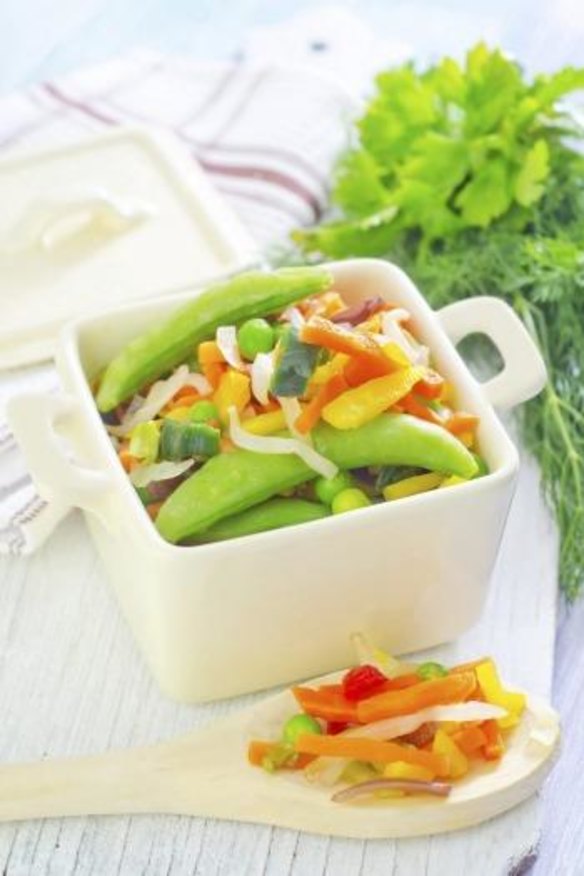How to grow snow peas in Canberra - gardening tips and advice

With the daytime temperatures falling a little, it is very pleasant to be out in the garden planting for the autumn harvests. The soil has been kept moist by the recent rains and we have sufficient water supplies to keep things going well.
It is still hot enough to have to provide short-term cover from the sun when planting out our seedlings of rainbow chard, broccoli and cauliflower. We should give all the little plants a dose of Seasol seaweed solution to help them settle in and establish their root systems.
But we will be moving into those autumn days soon enough, when both the daytime and night-time temperatures do fall away. I hear cheering from some folk and lamenting from others. You might tell me that your eggplants and capsicums are only just starting to produce well. And you want ongoing warm to push along your own lettuce seedlings for those late summertime salads.
For some other vegetables, we need to decide if we will be risk takers as a growing period of sixty plus days may now take us into the frost zones, post Anzac Day. I want to take a risk and see if things will work out. I planted out some rows of bush beans and they have germinated.
I think we have just enough time with warm weather to plant our one last garden bed of snow peas. That is, to produce a crop of delicious snow peas before the night-time frosts play havoc with the flowering. Maybe I will also plant out some sugar snap peas as well, to see how similar their growing habits are. We do have some self-sown peas coming up among the recent plantings of rocket and kale, so we shall see how they progress as well.
All family members of the pea family need a good "network" of support twines, twigs or wire netting to grow up tall and provide support for their little tendrils. Snow peas and sugar snap peas also like to grow in full sun and in a garden bed that is well drained. Dig in some compost and build up the bed a little to provide that drainage. Under good conditions you can expect a crop in 55-60 days after planting.
With snow peas, you have the benefits of the Chinese breeding programs that took place in the centuries following the introduction of peas from Europe during the 8th or 9th century AD. Chinese breeders sought to produce a crisp, edible pod that could be eaten whole and so the snow pea was developed. They were introduced back into western Europe only in the late 19th century. Of interest, the French adopted the word mangetout for snow peas, with its meaning of "eat all". Oregon sugar is a compact type snow pea variety. The pods are around 11 cm in length. They remain crisp yet tender and are full of flavour. Melting mammoth is a good option for cooler climates.
It will need a good growing support frame as it can grow up to 1.5 metres tall. It produces very good crops of larger sized snow peas. In the 1950s, plant breeders in the US sought to breed a thick podded, straight snow pea. They ended up breeding the delicious sugar snap pea with its very sweet pods filled with full size peas.
The sugar levels reach a peak when the pea seeds are fully developed. Some might call this outcome a case of serendipity. Sugar Ann is a dwarf-sized sugarsnap pea that is the sweetest of all and it is fast growing. Cascadia is the other good variety. It was bred at the Oregon State University and it produces a succulent crop of sugar snap peas over a longer period of time. It does need to have a good climbing frame as it can grow up to 1.25 metres tall.
As these members of the pea family are cool season crops, they are highly recommended for planting later in autumn to then produce a wonderful mid-spring crop in late October and November. This means that you are aiming for your next crop to mature when the likelihood of frosts has receded.
Snow pea and capsicum salad
1 red capsicum
1 green capsicum
1 red onion
½ red cabbage
400g snow peas
100g snow pea tendrils
60ml lemon juice
¼ cup peanut oil
1½ tbsp seeded mustard
Finely slice the capsicums and red onion. Finely shred the cabbage. Combine all in a large bowl and add in the snow pea tendrils and snow peas. Toss gently. Mix together the lemon juice, mustard and oil. Add the dressing to the salad just before serving.
This week in the garden
Plant out a selection of herbs including dill, borage and basil.
Plant seedlings of the fast maturing snowball cauliflower, oakleaf lettuces and early wonder beetroot.
Provide a foliar watering of seaweed extract or fish emulsion to all of your summer vegetable gardens.
Check your early maturing pears (Williams) and when the pips are beginning to darken, pick the fruit and store in a cool location for 10 days, to allow final ripening.
Check on all fruit laden branches of pears, apples and quinces and provide support where the branches are bending.
Owen Pidgeon runs the Loriendale Organic Orchard near Hall.